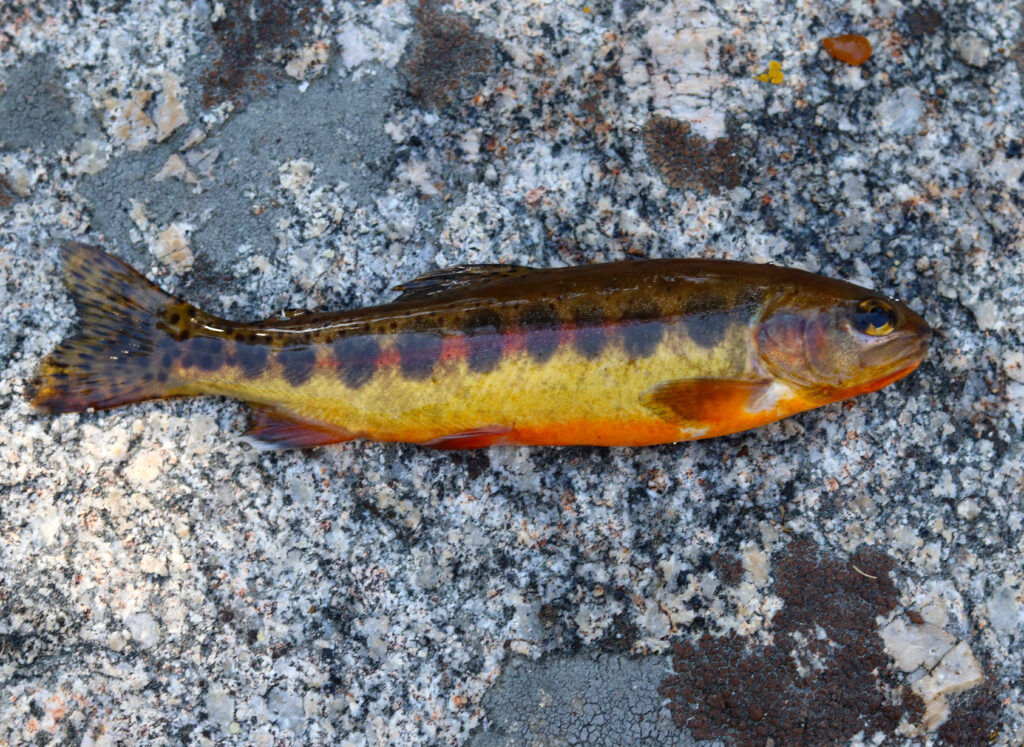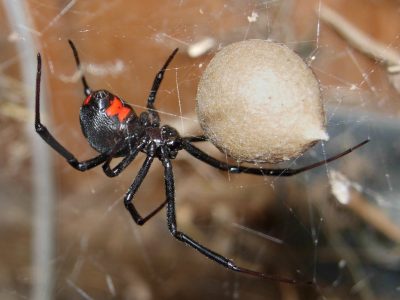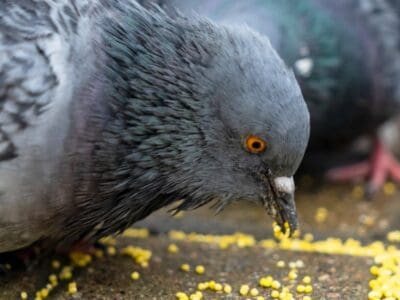Golden Trout
Oncorhynchus aguabonita
Freshwater state fish of California
Advertisement
Golden Trout Scientific Classification
- Kingdom
- Animalia
- Phylum
- Chordata
- Class
- Actinopterygii
- Order
- Salmoniformes
- Family
- Salmonidae
- Genus
- Oncorhynchus
- Scientific Name
- Oncorhynchus aguabonita
Read our Complete Guide to Classification of Animals.
Golden Trout Conservation Status
Golden Trout Facts
- Prey
- Terrestrial and aquatic invertebrates, crustaceans
- Main Prey
- Caddisflies and midges
- Name Of Young
- Fry
- Group Behavior
- School
- Fun Fact
- Freshwater state fish of California
- Estimated Population Size
- 400-2,600 (pure)
- Biggest Threat
- Competition with invasive fish
- Most Distinctive Feature
- Bright golden scales
- Distinctive Feature
- Red lateral line
- Other Name(s)
- California golden trout
- Gestation Period
- 20 days
- Average Spawn Size
- 300-2,300
- Habitat
- Freshwater streams and ponds
- Predators
- Kingfishers, herons, brook trout
- Diet
- Omnivore
- Favorite Food
- Invertebrates
- Special Features
- Live at high altitudes in cool waters
- Origin
- Kern River system
- Number Of Species
- -1
- Location
- Central California (native)
- Nesting Location
- Gravel beds
Golden Trout Physical Characteristics
View all of the Golden Trout images!
Also known as the California golden trout, Oncorhynchus aguabonita is the freshwater state fish of California. This rare species of Pacific trout is native to a few waterways near the southern end of the Sierra Nevada mountains. Widely considered one of the most beautiful trout in the world, golden trout sport colorful yellow, red, and glue-green scales. Unfortunately, California’s native golden trout is threatened due to competition from non-native species.

The largest golden trout ever caught measured 28 inches long and weighed 11.25 pounds.
©Sean Lema/Shutterstock.com
5 Facts
- You can find them at elevations up to 10,000 feet above sea level.
- NatureServe classifies them as a Critically Imperiled species.
- Experts can’t agree if they are their own species or a subspecies of rainbow trout.
- They have been introduced to numerous western states and some of these populations survive to this day.
- The largest ever caught measured 28 inches long and weighed 11.25 pounds.
Classification and Scientific Name
It belongs to the salmonid family Salmonidae, the sole extant family in the order Salmoniformes. This family includes numerous species, including trout, char, salmon, whitefishes, graylings, lenoks, and taimens. The family name derives from the Latin word salmo, meaning “salmon,” and -idae, meaning “like” or “form of.” The golden trout is a member of the Pacific salmon and Pacific trout genus Oncorhynchus. Its genus name stems from the Greek words ὄγκος (onkos), meaning “lump” or “bend,” and ῥύγχος (rhunkos), meaning “snout.” This name references the hooked snout developed by the males during the spawning season.
The taxonomy and classification of the golden trout remains hotly disputed by experts. Stanford University’s first President, David Starr Jordan, originally described the golden trout in 1892. At that time, Jordan named the golden trout Salmo mykiss agua-bonita. He named the fish after the Agua Bonita Waterfall where the first golden trout specimens were collected. Jordan classified it as a subspecies of rainbow trout (Oncorhynchus mykiss). However, some sources, including FishBase and the Catalog of Fishes, classify them as a separate species rather than a subspecies.
They are closely related to two other local fish species. The Kern River rainbow trout (O. m. gilberti) lives in the Kern River, while the Little Kern golden trout (O. m. whitei) lives in the Little Kern River basin. Experts sometimes refer to these three species as the “golden trout complex” due to their shared characteristics and range. Meanwhile, it gets its common name from the bright golden yellow scales on its belly.
Appearance
The first thing most people notice is their dazzling color. As their name suggests, they sport bright golden yellow scales on their lower sides. Meanwhile, the belly, lower jaws, and gill covers appear bright red or reddish orange. This fish also sport bright red lateral lines that run from the edge of each gill cover to the start of the anal fin. Each side features around 10 dark round marks known as parr marks. Golden trout also feature numerous black body spots. These spots occur primarily on and around the dorsal and caudal fins. The scales on the back vary but typically look olive or bluish green. The anal, lateral, and dorsal fins are usually edged with white and preceded by a black band.
They vary in size depending on their age, sex, and location. In their native habitat in central California, most specimens measure between 6 and 12 inches long. A typical one can weigh anywhere from 0.5 pounds to 1.25 pounds. However, transplanted golden trout can grow to larger sizes. The largest ever recorded measured 28 inches long and weighed 11.25 pounds.

Experts can’t agree if the golden trout is its own species or a subspecies of rainbow trout.
©Aleksandra_Chukcha/Shutterstock.com
Distribution, Population, and Habitat
Up until the early 20th century, you could only find golden trout in a few waterways located in the southern Sierra Nevada mountains in central California. These waterways include the Kern River and its major tributaries, Golden Trout Creek and Volcano Creek. Soon after its discovery, they quickly soared in popularity as a gamefish. Many attempts have been made over the last 100 years to introduce golden trout into new habitats. Today, you can find populations in Idaho, Utah, Washington, Montana, Colorado, and Wyoming. While some of these populations failed to survive, others persist to this day. That said, many of these transplanted populations bred with local rainbow or cutthroat trout, thereby creating hybrid offspring. As such, experts differentiate these hybrids from the “pure” golden trout in California.
In California, they live at elevations ranging from 6,890 feet to 10,000 feet above sea level. They prefer water temperatures between 58 and 62 degrees Fahrenheit but can tolerate temperatures up to 70 degrees Fahrenheit. Their native habitat consists mainly of riparian meadows. You’re often likely to encounter rainbow trout in short streams, pols, or beneath undercut banks. Outside of their native range, golden trout live in a wide variety of streams, rivers, and lakes.
Predators and Prey

In their native range, golden trout historically had very few natural predators. Their list of common predators includes birds such as
kingfishers
.
©Rudmer Zwerver/Shutterstock.com
In their native range, golden trout historically had very few natural predators. Their list of common predators includes birds such as kingfishers or herons. However, the introduction of invasive species to their native habitat greatly changed this equation. Today, they face competition for food from brook trout. Additionally, introduced brown trout often prey upon their eggs and juveniles.
They are opportunistic carnivores that prey on a wide range of species. In the Kern River system, golden trout mainly prey on aquatic and terrestrial invertebrates. Some of their main sources of food include caddisflies, midges, and small crustaceans. They feed by swallowing prey whole.
Reproduction and Lifespan
They typically reach sexual maturity between 2 and 4 years old. The spawning season begins in spring or early summer as water temperatures start to warm. Mating peaks in the late afternoon during the warmest part of the day. Females lay their eggs in shallow nests dug in gravel beds. Males then externally fertilize the eggs with their sperm. On average, a female golden trout will lay anywhere from 300 to 2,300 eggs. After around 20 days, the eggs hatch, and the fry emerge. As they grow, fry move from the substrate to more open water to feed. In the wild, golden trout can live up to 9 years.
Food and Cooking

When cooked, golden trout possess firm red flesh, and the skin turns pale gold.
©Sergii Koval/Shutterstock.com
U.S. Air Force Officer and record-setting test pilot Chuck Yeager once ranked it as one of the best game fish he’d ever eaten. When cooked, it possesses firm red flesh, and the skin turns pale gold. While some claim that it tastes somewhat fishy and bitter, others rate its meat as semi-sweet. You can prepare it in several ways, including roasted, baked, fried, or grilled. Frying and roasting rank among the most popular methods due to the small size of filets. That said, you’re unlikely to find golden trout on many restaurant menus. If you want to try the meat, you’ll most likely need to catch one yourself.
Golden Trout Population
Prior to the 20th century, populations remained relatively stable for thousands of years. In 1965, experts estimated that around 40,000 golden trout lived in the South Fork Kern River and Golden Trout Creek. Today, only 400 to 2,600 remain in their native habitat. Most of these live in a 3-mile stretch of Volcano Creek. This equates to a drop of nearly 95% in the past 60 years. That said, transplanted populations continue to thrive in non-native habitats. However, little data exists on the status of these populations. California lists them as a State Species of Special Concern. Meanwhile, NatureServe classifies the golden trout as Critically Imperiled.
View all 170 animals that start with GGolden Trout FAQs (Frequently Asked Questions)
Are golden trout carnivores, herbivores, or omnivores?
Golden trout are opportunistic carnivores that mostly feed on aquatic and terrestrial invertebrates. Their prey includes small crustaceans, caddisflies, and midges.
How long can golden trout live?
Golden trout can live up to 9 years in the wild and reach sexual maturity around 2 or 3 years of age.
Where can you find golden trout?
Historically, pure golden trout could only be found in the Kern River system and its tributaries, including Volcano Creek and Golden Trout Creek. Today, you can find hybridized golden trout in select waterways across the American West.
How big do golden trout get?
“Pure” golden trout typically measure around 8 inches long but can range from 6 to 12 inches long. The largest hybrid golden trout on record measured 28 inches long and weighed 11.25 pounds.
Thank you for reading! Have some feedback for us? Contact the AZ Animals editorial team.
Sources
- , Available here: https://caltrout.org/sos/species-accounts/trout/california-golden-trout
- , Available here: https://wildlife.ca.gov/Fishing/Inland/California-Golden-Trout
- , Available here: https://wildlife.ca.gov/Conservation/Fishes/California-Golden-Trout
- , Available here: https://www.sierrawild.gov/wilderness/golden-trout/


















